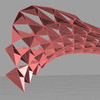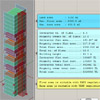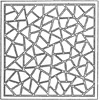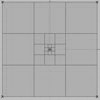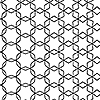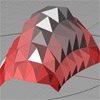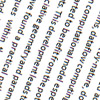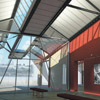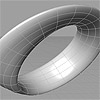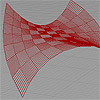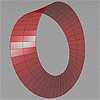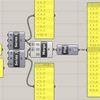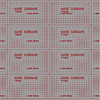In this experiment, I’m trying to use data recorder to change components on a surface. The component part is a standart triangular construction, but the attractor points are defined by a 2D slider that is connected to a data recorder. Data recorder remembers last 15 points, while you move the 2d slider, last 15 points are projected on the base surface. This creates an illusion as if a “snake” game […]
At the initial design phase of an apartment project in İstanbul, Nilüfer Kozikoğlu (TUŞPA Architecture) has offered me a job I haven’t done in Grasshopper before. This definition includes a sketch of a possible apartment renewal, analyzing and optimizing data from the contractor’s and property owners’ perspective. It also checks if the proposed solution is appropriate according to the building regulations for that area. In Turkish, KAKS means the maximum […]
The design of Chinese window lattices named “ice-ray” is one of the classic studies of Shape Grammars. It is an old and good example of algorithmic design. George Stiny explained their geometric construction based on the parametric Shape Grammars approach. He explained shape rules and the abstract machine that produces the subdivisions. I was especially interested in Shape Grammars when I was a graduate student. I even made a prototype […]
In order to start creating recursive algorithms in Grasshopper, I finally managed to run Hoopsnake, a special component developed by Yiannis Chatzikonstantinou. This will help me develop parametric models that include loops. The fundamental experiment here shows a surface subdivision based on iterations. We should define a starting object or data, an operation to be repeated, and a limit that will tell Hoopsnake to stop looping. In this condition, this […]
This is another starting point for pattern generation study in a dataflow environment. I tried to implement the parquet deformation of Islamic patterns in Grasshopper. I studied Hankin’s method of Islamic Pattern generation. Then I tried to simulate his process beginning with basic regular tiling (regular hexagonal tessellation). Craig S. Kaplan (here) explains this and other methods in his dissertation. A Simple Foundation We have already experienced the result of […]
This study includes three main topics related to the basics of Grasshopper. The first one is the surface subdivision, the parametric definition of a surface component, that is, in this case, a simple pyramidal object. The second thing is the associative behavior of surface components with an external parameter, that is another entity in space; a curve. Traditionally, this is simply demonstrated by 1) finding the area centroids of each […]
Information Age has been transforming architecture, provoking its theoretical and methodological foundations. We might call this as a paradigm shift or not; it’s obvious that contemporary research fields and built practices lead architectural design into a certain revolution. Mainstream schools of design education are becoming more involved in this revolution, with a common purpose; the need to construct a logical connection between contemporary design theories utilizing methods called popularly as […]
A previous work showed a method to create interlocking structures to be created without boolean operations. This time, a small addition is made to create waffle objects using two surfaces, one is the top surface, and the other is the bottom. It was a small modification at the beginning; to replace the “extrude” component with an “edge surface” component. But the interlocking details are now different at each intersection, so […]
This was a design competition of a precast concrete roof system. My design proposal was a modular and variable structure for İstanbul’s old bus station, converted to art galleries. However, this project was developed purely by hand-sketches, I’m planning to create an envelope of alternatives by creating a parametric model. Each module is proposed to be converted differently in order to meet various functions such as single or double module […]
The regular component design technique can be further improved by adding several manipulations. The purpose of this study was to create a surface component that reacts to an inherent parameter (actually a geodesic curve on the surface). However, within the process of parametric modeling, diverse formal potentials emerged. Most interesting results are achieved by adding a graph parameter to control the waves of reaction while splitting the surface as stripes. […]
This was a couple of months ago, Nilüfer Kozikoğlu (TUŞPA Architecture) has offered a design for a competition, the new TV Tower in İstanbul. Her design intention was mainly focused on the spatial qualities of the observation decks and the visual interpretations on the overall shape of the tower. Interesting part of this project was the experience of a collaborative design process. Nilüfer sketched her design ideas in Rhinoceros, and I […]
A Moebius strip, also known as a Moebius band, is a fascinating mathematical object and a type of non-orientable surface. It was discovered independently by the German mathematicians August Ferdinand Möbius and Johann Benedict Listing in the 19th century. To visualize a Moebius strip, imagine taking a long, narrow strip of paper and giving it a half twist before connecting its ends to form a loop. The result is a […]
This is a basic formation of component-based design in a dataflow environment. A double-curved surface is subdivided and re-constructed using straight sections. Parametric model of a surface construction by variable components. The main data list of subsurfaces are distributed into four distinct lists, that will be used to construct lines out of double-curved quadrilateral faces. Such definitions could be further advanced by adding a precise fabrication detail. Parametric definition can […]
Design computing in architecture is evolved enough to form a more spread out advance, instead of being an alternative way of thinking and practising. Contemporary architectural practice is beginning to push forward such a transformation. This also effects architectural education, that is beginning to focus on digital design paradigm especially at undergraduate level not only in experimental studios, but also in formal education. Design studios however, play an important role […]
One of the most popular shapes in topology studies is the one-edge, one-face Moebius strip. Here is a basic definition that generates Moebius-like lofted surfaces. I say Moebius-like because, in Grasshopper, Rhino, or any NURBS surface method, I couldn’t manage to model this shape in its real topological singularity. The tricky part of this Grasshopper definition lies at the end, as I take the first segment of the surface, flip […]
Here are some basic references to Grasshopper’s handling of objects. As the most powerful and intuitive part of such Visual Programming Languages is the focus of dataflow, the critical part of it’s education lies at the fundamentals of data tree manipulations. Designers using these tools should understand and predict the type of data trees his/her parametric model would process. Here is the Grasshopper document including these components; [2012_01_10-adding streams] We’ll start […]
This was an interesting challenge for me to find out if an architect can use Visual Programming Languages (VPL’s) also for graphical purposes? Now, I would say “not exactly” because this definition took much time than I expected. The aim was to create an algorithm for a business card design that has variable outputs. Each card should be different, but without using any randomization. This is achieved with a definition […]

